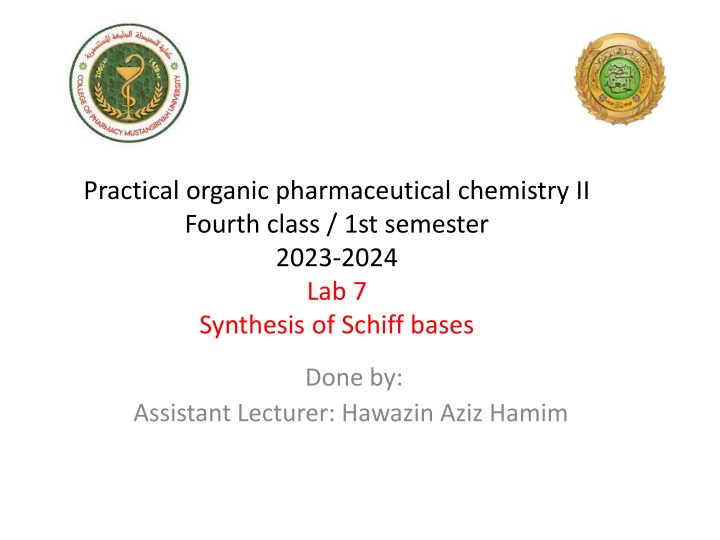
Synthesis of Schiff Bases in Organic Pharmaceutical Chemistry Lab
Learn about the significance of Schiff bases, their synthesis methods, mechanisms, and applications in organic chemistry. Discover how Schiff bases play a vital role in enzymatic reactions and the development of metal complexes in coordination chemistry. Understand the structural characteristics and stability factors of different Schiff bases in various chemical reactions.
Download Presentation

Please find below an Image/Link to download the presentation.
The content on the website is provided AS IS for your information and personal use only. It may not be sold, licensed, or shared on other websites without obtaining consent from the author. If you encounter any issues during the download, it is possible that the publisher has removed the file from their server.
You are allowed to download the files provided on this website for personal or commercial use, subject to the condition that they are used lawfully. All files are the property of their respective owners.
The content on the website is provided AS IS for your information and personal use only. It may not be sold, licensed, or shared on other websites without obtaining consent from the author.
E N D
Presentation Transcript
Practical organic pharmaceutical chemistry II Fourth class / 1st semester 2023-2024 Lab 7 Synthesis of Schiff bases Done by: Assistant Lecturer: Hawazin Aziz Hamim
Lecture objectives 1-Introduction of Schiff base 2-Synthesis of Schiff bases 3-Mechanism 4-Procedure
Schiff bases 1-Introduction Schiff bases are condensation products of primary amines and carbonyl compounds and they were discovered by a German chemist, Nobel Prize winner, Hugo Schiff in 1864. Schiff-bases are considered as a very important class of organic compounds and have a wide application in many biological aspects, proteins, visual pigments, enzymatic like
Schiff bases appear to be an important intermediate in a number of enzymatic reactions involving interaction of an enzyme with an amino or a carbonyl group of the substrate. One of the most important types of catalytic mechanism is the biochemical process which involves the condensation of a primary amine in an enzyme usually that of a lysine* residue, with a carbonyl group of the substrate to form an imine, or Schiff base and decarboxylation reactions.
Moreover, some Schiff-bases were exhibits antibiotic, antiviral and antitumor agents because of their specific structure. Structurally, Schiff base (also known as imine or azomethine) is an analogue of a ketone or aldehyde in which the carbonyl group (C=O) has been replaced by an imine or azomethine group .
Schiff base ligands are essential in the field of coordination chemistry, especially in the development of complexes of Schiff bases because these compounds are potentially capable of forming stable complexes with metal ions Where R, may be an alkyl or an aryl group. Schiff bases that contain aryl substituents are substantially more stable and more readily synthesized, while those which contain alkyl substituents are relatively unstable. Schiff bases of aliphatic aldehydes are relatively unstable and readily polymerizable , while those of aromatic aldehydes having effective conjugation are more stable
The formation is generally driven to the completion by separation of the product or removal of water, or both. Many Schiff bases can be hydrolyzed back to their aldehydes or ketones and amines by aqueous acid or base. The reaction of aldehyde with amine drugs is the most common reactions to synthesize compound (Schiff base or imine). Imines are formed in a reversible.
2-Synthesis of Schiff bases The formation of a Schiff base from an aldehydes or ketones is a reversible reaction and generally takes place under acid or base catalysis, or upon heating. The formation is generally driven to the completion by separation of the product or removal of water, or both. Many Schiff bases can be hydrolyzed back to their aldehydes or ketones and amines by aqueous acid or base.
acid catalyzed process that begins with nucleophilic addition of the primary amine to the carbonyl group, followed by the transfer of a proton from nitrogen to oxygen to yield a neutral amino alcohol, or carbinolamine. Protonation of the carbinolamine oxygen by an acid catalyst then converts the OH into a better leaving group (-OH2), and loss of water produces an iminium ion. Loss of a proton from nitrogen gives the final product and regenerates the acid catalyst as shown in Scheme
Typically carbinolamine is the rate-determining step of Schiff base formation and that is why the reaction is catalyzed by acids. Yet the acid concentration cannot be too high because amines are basic compounds. If the amine is protonated and becomes non-neucleophilic, equilibrium is pulled to the left and carbinolamine formation cannot occur. Therefore, many Schiff bases synthesis are best carried out at mildly acidic pH. the dehydration of the
Schiff bases (Amoxicillin + Benzaldehyde) )
4-Procedure: 1-Add 0.5 ml of benzaldehyde in round flask then add 2.5ml ethanol. 2-Place 500 mg of Amoxicillin in round flask and mix well. 3-Add 2 drops of glacial acetic acid into mixture. 4-Heating and stirring 10 min. 5-Cool the mixture and add crashed ice and mix. 6- Filtered the ppt
Questions Q1/Why Schiff-bases are considered as a very important class ? Q2/ R, may be an alkyl or an aryl group in schiff base , what are more stable and why ? Q3/ what are the rate-determining step of Schiff base formation ? Q4/why we use HCl in formation of schiff base ?






















